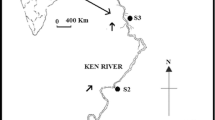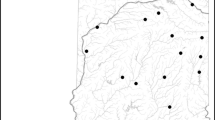Abstract
Permanent meiofauna taxa and portions of the population of other invertebrates that are temporarily in the meiofauna size class are often precluded from stream studies and assessments. This study was designed to determine the identity, density, and distribution of major meiofauna taxa relative to substrate size in a set of similar headwater streams. Using a coring technique, meiofauna (80 μm–1 mm) and substrate samples were collected from 11 Ozark headwater streams in the Boston Mountain ecoregion of Arkansas, USA. Mean meiofauna density among streams was 1739 ± 436 organisms per l. Permanent meiofauna taxa (Copepoda, Cladocera, Ostracoda, Rotifera, Nematoda, Hydrachnida, and Tardigrada) comprised 22.5% of the organisms collected with a mean density of 394 ± 233 organisms per l; temporary meiofauna taxa (Oligochaeta, Turbellaria, Hydroidea, Chironomidae, Ephemeroptera, and other insects) comprised the remainder with a density of 1346 ± 308 organisms per l. Chironomidae was the most numerous temporary meiofauna taxon, and Hydrachnida was the most numerous permanent taxon. Streams were found to differ significantly in substrate composition and densities of major taxonomic categories. Substrate size was found to predict densities for most of these taxonomic categories. Meiofauna patchiness was reflected in high variability within streams. Canonical correspondence analysis revealed positive associations between Copepoda and Nematoda and silt, and between Copepoda, Nematoda, and Rotifera and fine sand. Hydrachnida and Rotifera were negatively associated with silt and coarse sand, respectively. The potential value of inclusion of meiofauna in stream environmental assessments is discussed.



Similar content being viewed by others
References
ADPCE Arkansas Department of Pollution Control and Ecology (1998) Regulation establishing water quality standards for surface waters of the state of Arkansas, Regulation 2, as amended, Little Rock
Amores-Serrano RR (1991) Stream-dwelling meiofauna: temporal abundance, distribution and utilization by larval fish. Dissertation, University of Arkansas, Fayetteville
Barbour MT, Gerritsen J, Snyder BD, Stribling JB (1999) Rapid bioassessment protocols for use in streams and wadeable rivers: periphyton, benthic macroinvertebrates, and fish, 2nd edn. EPA 841-B-99-002. U.S. Environmental Protection Agency, Office of Water, Washington, DC
Bourassa N, Morin A (1995) Relationships between size structure of invertebrate assemblages and trophy and substrate composition in streams. J N Am Benthol Soc 14:393–403
Brown AV, Radwell AJ, Reese RA (2003) Bioassessment of the West Fork of the White River, Northwest Arkansas: a survey of fishes, macroinvertebrates, and meiofauna. Arkansas Water Resources Center MSC-307, Fayetteville
Cowell BC, Remley AH, Lynch DM (2004) Seasonal changes in the distribution and abundance of benthic invertebrates in six headwater streams in central Florida. Hydrobiologia 522:99–115
Fleeger JW, Thistle D, Thiel H (1988) Sampling equipment. In: Higgins RP, Thiel H (eds) Introduction to the study of meiofauna. Smithsonian Institution Press, Washington, DC, pp 115–125
Giere O (1993) Meiobenthology – the microscopic fauna in aquatic sediments. Springer-Verlag, Berlin
Hahn HJ (2002) Distribution of the aquatic meiofauna of the Marbling Brook catchment (Western Australia) with reference to landuse and hydrogeological features. Arch Hydrobiol Suppl 139:237–263
Hakenkamp CC, Morin A (2000) The importance of meiofauna to lotic ecosystem functioning. Freshwat Biol 44:165–175
Hakenkamp CC, Palmer MA (2000) The ecology of hyporheic meiofauna. In: Jones J, Mulholland P (eds) Streams and ground waters. Academic Press, New York, pp 307–336
Maridet L, Wasson J, Phillippe M (1992) Vertical distribution of fauna in the bed sediment of three running water sites: influence of physical and trophic factors. Regul Rivers Res Manage 7:45–55
Montgomery DC (1997) Design and analysis of experiments, 4th edn. John Wiley and Sons, New York
Olsen DA, Townsend CR (2003) Hyporheic community composition in a gravel-bed stream: influence of vertical hydrological exchange, sediment structure and physicochemistry. Freshwat Biol 48:1363–1378
Omernik JM (1987) Ecoregions of the conterminous United States. Ann Assoc Amer Geog 77:118–125
Palmer MA (1990) Temporal and spatial dynamics of meiofauna within the hyporheic zone of Goose Creek, Virginia. J N Am Benthol Soc 9:17–25
Pennak RW (1988) Ecology of freshwater meiofauna. In: Higgins RP, Thiel H (eds) Introduction to the study of meiofauna. Smithonian Institution Press, Washington, DC, pp 39–60
Radwell AJ, Brown AV (2006) Influence of fine sediments on meiofauna colonization densities in artificial stream channels. Arch Hydrobiol 165:63–75
Radwell AJ, Kwak TJ (2005) Assessing ecological integrity of Ozark rivers to determine suitability for protective status. Environ Manage 35:799–810
Richards C, Bacon KL (1994) Influence of fine sediment on macroinvertebrate colonization of surface and hyporheic stream sediments. Great Basin Nat 54:106–113
Robertson AL, Rundle SD, Schmid-Araya JM (2000) Putting the meio- into stream ecology: current findings and future directions for lotic meiofauna research. Freshwat Ecol 44:177–183
Rosenberg DM, Resh VH (eds) (1993) Freshwater biomonitoring and benthic macroinvertebrates. Chapman and Hall, New York
Rundle SD, Robertson AL, Schmid-Araya JM (eds) (2002) Freshwater meiofauna: biology and ecology. Backhuys Publishers, Leiden, The Netherlands
Schmid-Araya JM, Hildrew AG, Robertson A et al (2002) The importance of meiofauna in food webs: evidence from an acid stream. Ecology 83:1271–1285
Shiozawa DK (1991) Microcrustacea from the benthos of nine Minnesota streams. J N Am Benthol Soc 10:286–299
Smith MJ, Kay WR, Edward DHD et al (1999) AusRivAS: using macroinvertebrates to assess ecological condition of rivers in Western Australia. Freshwat Biol 41:269–282
Smith F, Brown AV, Michael JL (2001a) Benthic meiofauna responses to five forest harvest methods. Hydrobiologia 464:9–15
Smith F, Brown AV, Pope ML (2001b) Meiofauna in intermittent streams differ among watersheds subjected to five methods of timber harvest. Hydrobiologia 464:1–8
Smith IM, Cook DR, Smith BP (2001c) Water mites (Hydrachnida) and other arachnids. In: Thorp JH, Covich AP (eds) Ecology and classification of North American freshwater invertebrates, 2nd edn. Academic Press, San Diego, pp 551–659
Strayer DL, May SE, Nielsen P, Wollheim W, Hausam S (1997) Oxygen, organic matter and sediment granulometry as controls on hyporheic animal communities. Arch Hydrobiol 140:131–144
Stead TK, Schmid-Araya JM, Hildrew AG (2005) Secondary production of a stream metazoan community: does the meiofauna make a difference? Limnol Oceanogr 50:398–403
Stein BA, Kutner LS, Hammerson GA, Master L, Morse LE (2000) State of the states – geographic patterns of diversity, rarity, and endemism. In: Stein BA, Kutner LS, Adams JS (eds) Precious heritage – the status of biodiversity in the United States. Oxford University Press, New York, pp 119–157
Swan CM, Palmer MA (2000) What drives small-scale spatial patterns in lotic meiofauna communities? Freshwat Biol 44:109–121
ter Braak CJF, Looman CWN (1994) Biplots in reduced-rank regression. Biom J 36:983–1003
ter Braak CJF, Smilauer P (1998) CANOCO reference manual and user’s guide to Canoco for Windows: software for canonical community ordination (version 4). Microcomputer Power, Ithaca, NY
Waters TF (1995) Sediment in streams: sources, biological effects and control. American Fisheries Society Monograph 7. American Fisheries Society, Bethesda, MD
Wood PJ, Armitage PD (1997) Biological effects of fine sediment in the lotic environment. Environ Manage 21:203–217
Wright JF, Sutcliffe DW, Furse MT (eds) (2000) Assessing the biological quality of freshwaters: RIVPACS and similar techniques. Freshwater Biological Association, Ambleside, England
Acknowledgements
The time and energy of numerous people who assisted with collecting field data including Jan Hinsey, Terri Phelan, Robin Reese, and Paul Justus is genuinely appreciated. We wish to acknowledge Dr. Edward Gbur’s assistance and review of the statistical analyses of our research.
Author information
Authors and Affiliations
Corresponding author
Rights and permissions
About this article
Cite this article
Radwell, A.J., Brown, A.V. Benthic meiofauna assemblage structure of headwater streams: density and distribution of taxa relative to substrate size. Aquat Ecol 42, 405–414 (2008). https://doi.org/10.1007/s10452-007-9108-0
Received:
Accepted:
Published:
Issue Date:
DOI: https://doi.org/10.1007/s10452-007-9108-0




